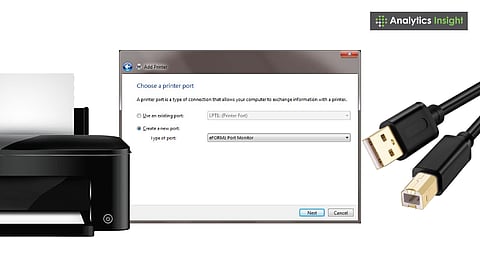

Windows 11 simplifies USB printer setup with automatic port detection.
Manual port configuration ensures compatibility with older printers.
Proper driver installation guarantees smooth and error-free printing.
Setting up a printer may feel like a hassle, but Windows 11 has streamlined the process. Regardless of whether you're installing a new printer or reconnecting an older printer, connecting via USB is the fastest way to get up and running. In just a matter of minutes, you can install drivers, adjust settings and get to printing.
A USB printer port functions as a connection interface between your computer and the printer. It enables Windows 11 to communicate with the printer, allowing you to print documents. Usually, when you plug in a printer, Windows notices right away. However, you may need to add the port manually, especially when using an older printer or if the printer software encounters errors.
Also Read: Amazon Great Indian Festival Live: Best Deals on Monitors & Printers
First things first, use the printer's USB cable and plug it into your computer. Ensure that the printer is powered on. Windows 11 should detect it and notify you that it has found something new.
If no pop-up appears, it is not a major problem. It simply means that Windows hasn't recognized the printer yet. You can still set it up manually.
Click the Start button, then head to Settings → Bluetooth & Devices → Printers & Scanners. This is where all the printer settings and connected devices are displayed.
You'll see a list of all your printers and scanners. If your printer isn't detected, click Add Device and let Windows search for it.
Most printers these days are easy to operate. When you plug it in, Windows 11 should automatically install any necessary updates. If the printer appears on the list, click 'Add Device' next to it. The setup should now be complete.
But if Windows can't find the printer, you should add that USB port manually.
On the same Printers & Scanners page, scroll down and click 'Add manually'. Then, select ‘Add a local printer or network printer with manual settings.’
Next, select 'Use an existing port'. In the list, find the one that starts with 'USB', such as USB001 (Virtual Printer Port for USB). Click Next to continue.
Windows will likely prompt you to install a driver. You have two options at this stage:
Option 1: See if your printer is on the list and pick it.
Option 2: If it's not there, click ‘Have Disk’ and locate the folder containing the driver. The driver may be included with the printer or available for download from the manufacturer’s website.
If you print often, making the printer the default is a good idea. To do it, head to Settings, then Printers & Scanners. Pick the printer you want and click 'Set as default.'
Now, verify that the printer is functioning correctly. Open Printer Properties and click Print Test Page. If the printer prints, you're all set! If not, check the cable, ensure you have selected the correct port, and verify that the software is installed correctly.
Also Read: Top Sublimation Printers to Buy in 2025
Troubleshooting Tips
Try a different USB port.
Reinstall the printer driver (or update it).
Restart your computer and the printer.
Run the Windows Troubleshooter (Settings → System → Troubleshoot → Other Troubleshooters → Printer).
These steps typically resolve most minor connectivity issues.
Connecting a USB printer in Windows 11 is a straightforward process. In most cases, Windows automatically completes the setup. Even if it does not, manual configuration takes only a few steps. Following these instructions will ensure your printer is ready to use quickly.
1. How do I add a USB printer to Windows 11?
Go to Settings → Bluetooth & Devices → Printers & Scanners → Add Device and select your connected USB printer.
2. Why is my USB printer not showing up in Windows 11?
The printer may require updated drivers or a manual port setup by selecting 'Add a local printer with manual settings'.
3. How can I find my printer port in Windows 11?
Open Control Panel → Devices and Printers → Printer Properties → Ports to see or change the assigned USB port.
4. What should I do if Windows 11 doesn’t detect my printer automatically?
Try another USB port, reinstall the drivers, or use 'Add Printer Manually' in the Printers & Scanners menu.
5. Can I make my USB printer the default printer in Windows 11?
Yes. Go to Settings → Printers & Scanners, select the printer, and click Set as default.
